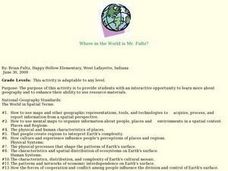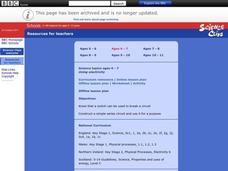Curated OER
The Value of a Garden
Students explore the history of taxonomy, the work of Carl Linnaeus, and the factors involved in the decline and extinction of a variety of botanical species.
Curated OER
Global Women and Poverty
Students examine poverty and women in Senegal through a video. They work together to gather research about economic prosperity in different countries. They share their information with the class.
Curated OER
Tolerance in Times of Trial
Students view the treatment of people of Japanese and German descent during World War II. They explore the problems in assigning blame to populations during times of war. They identify modern examples of discrimination and stereotyping.
Curated OER
Our Population and Its Impact on the Planet
Students explore environmental problems due to the growing worldwide human population and examine the growth rate. They also discuss possible ways to stabilize population growth and increase sustainable development.
Curated OER
Decolonization and Self-Determination
Students define and discuss colonialism and self-determination. After reading the European's view on the topic, they analyze a map of imperialism in 1914. They watch excerpts of a video and take notes on various United Nations...
Curated OER
Where in the World is Mr. Fultz?
Students use maps and other geographic resources to learn about their world while problem solving. They read clues each day and use classroom resources to narrow down where the prize is located.
Curated OER
Forces in Action
Students investigate questions centered around force and motion by going through the scientific process and creating fair tests and experimentation. In this instructional activity about forces-in-action, students diagram their findings...
Curated OER
Reversible and irreversible changes
Students experiment with solids and liquids to find which solids will dissolve in water. This dissolution and mixtures lesson can be completed online or in class as all materials are connected to the lesson plan for both settings.
Curated OER
Using Electricity
Students read The Lighthouse Keeper's Lunch to become familiar with the way a lighthouse works.In this using electricity lesson, student create lighthouses with plasticine clay and a working circuit. Students complete a worksheet on...
Curated OER
Sorting and Using Materials
Young scholars explore materials and their properties. In this matter lesson, students identify objects and describe their properties. Young scholars test and sort materials using an interactive whiteboard, followed by a group discussion...
Curated OER
Friction
Students compare and contrast the movement of objects on different surfaces, experimenting with friction and forces of motion. This friction lesson has numerous online tools including worksheets and virtual activities; the option is also...
Curated OER
Elements for Disaster Reporting
Students identify the elements of natural disasters and gain an understanding on how the media influences people's responses to disasters. In this natural disaster lesson plan, students study the impact of natural disasters, and the...
Curated OER
How We See Things
Students investigate how mirrors reflect light. In this reflection lesson, students draw the path of the light reflected from a mirror. Students construct a list of objects that are light sources.
Curated OER
Oil Changes Everything
Students participate in a hands on activity simulating an oil spill. In this oil spill lesson plan, students conduct an experiment about an oil spill, discuss how it would affect the environment and provide solutions to prevent oil spills.
Curated OER
Stream Study
Students study the characteristics of a stream habitat. For this life science lesson, students use sieves, nets, and jars to collect aquatic organisms. Students also measure the temperature of the stream and calculate the speed of the...
Curated OER
What is Framing?
Students practice framing issues. In this writing skills lesson, students participate in a classroom activity that requires them to look at specific topical issues by framing them. Students then create collages on current issues and...
Curated OER
Journeys...The Voices of Change
Students trace the immigration patterns of their ancestors. They plot information on a world map, develop a timeline of target immigration patterns, research and write a report on immigration and participate in a class play.
Curated OER
Food for Thought
Students understand the importance of each member of a food chain through a game. In this food chains lesson, students receive background information and then play a game to simulate what happens in the food chain of an endangered...
Curated OER
Pond Life Identification Kit
Students explore ecology and biodiversty. They use the wet-mount procedure to make several slides to view using the microscope and draw what they see.
Curated OER
Earth's Ecosystem: Seven Major Biomes
Students discuss the different types of ecosystems and the composition of biomes. Working in groups, they define various related terms and make posters of them. Then they explain their posters to the class.
Curated OER
Government Lesson Plan 11
Students apply United Nations' Universal Declaration of Human Rights (UDHR) and the United States Constitution to contemporary situations, and predict possible United Nations responses to violations of the UDHR.
Curated OER
Describe the Perfect Pathogen
High schoolers develop a pathogen based upon their knowledge of pathogens and after presenting it to the class, they then suggest ways that the pathogen might be combated. Next they identify possible physical or behavioral changes in a...
Curated OER
Flowers: Form and Function
Students recognize and name the parts of a flower. They explain the function of each part of a flower. Students list the steps that occur for sexual reproduction of a plant to take place. They recognize and name the male reproductive...
Curated OER
Cypress/Tupelo Swamps
Students study the geologic history of terrain, soils, and drainage patterns. They recognize ecological processes that determine the dynamic nature of habitats. They investigate the influence of human activity on the landscape.

























